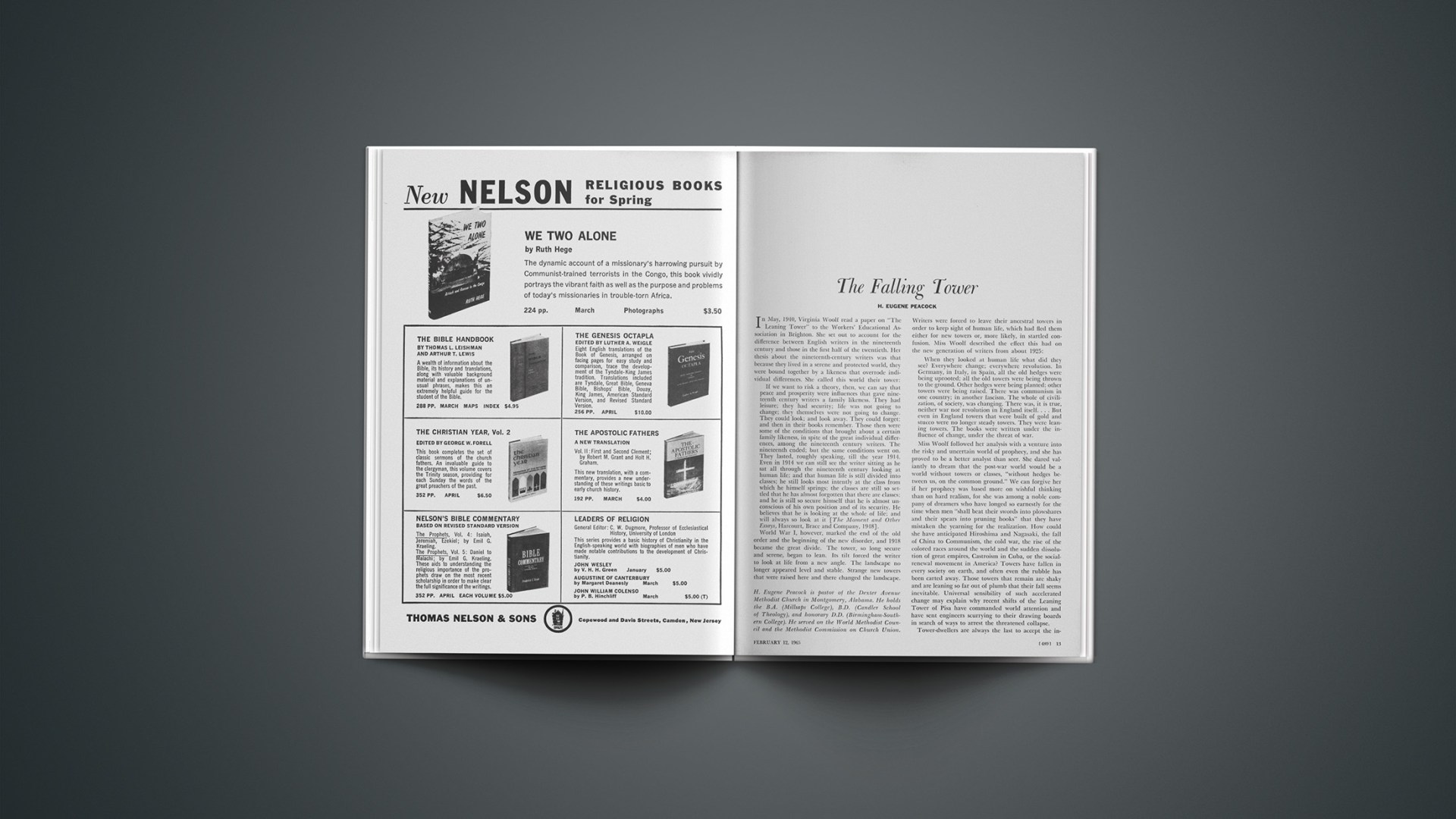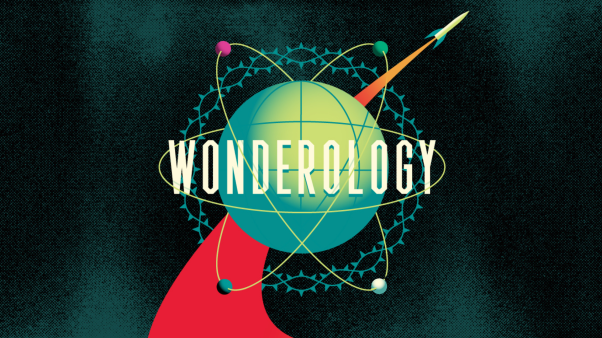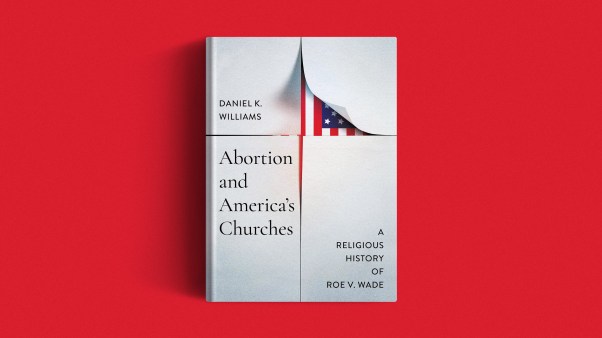In May, 1940, Virginia Woolf read a paper on “The Leaning Tower” to the Workers’ Educational Association in Brighton. She set out to account for the difference between English writers in the nineteenth century and those in the first half of the twentieth. Her thesis about the nineteenth-century writers was that because they lived in a serene and protected world, they were bound together by a likeness that overrode individual differences. She called this world their tower:
If we want to risk a theory, then, we can say that peace and prosperity were influences that gave nineteenth century writers a family likeness. They had leisure; they had security; life was not going to change; they themselves were not going to change. They could look; and look away. They could forget; and then in their books remember. Those then were some of the conditions that brought about a certain family likeness, in spite of the great individual differences, among the nineteenth century writers. The nineteenth ended; but the same conditions went on. They lasted, roughly speaking, till the year 1914. Even in 1914 we can still see the writer sitting as he sat all through the nineteenth century looking at human life; and that human life is still divided into classes; he still looks most intently at the class from which he himself springs; the classes are still so settled that he has almost forgotten that there are classes; and he is still so secure himself that he is almost unconscious of his own position and of its security. He believes that he is looking at the whole of life; and will always so look at it [The Moment and Other Essays, Harcourt, Brace and Company, 1948].
World War I, however, marked the end of the old order and the beginning of the new disorder, and 1918 became the great divide. The tower, so long secure and serene, began to lean. Its tilt forced the writer to look at life from a new angle. The landscape no longer appeared level and stable. Strange new towers that were raised here and there changed the landscape. Writers were forced to leave their ancestral towers in order to keep sight of human life, which had fled them either for new towers or, more likely, in startled confusion. Miss Woolf described the effect this had on the new generation of writers from about 1925:
When they looked at human life what did they see? Everywhere change; everywhere revolution. In Germany, in Italy, in Spain, all the old hedges were being uprooted; all the old towers were being thrown to the ground. Other hedges were being planted; other towers were being raised. There was communism in one country; in another fascism. The whole of civilization, of society, was changing. There was, it is true, neither war nor revolution in England itself.… But even in England towers that were built of gold and stucco were no longer steady towers. They were leaning towers. The books were written under the influence of change, under the threat of war.
Miss Woolf followed her analysis with a venture into the risky and uncertain world of prophecy, and she has proved to be a better analyst than seer. She dared valiantly to dream that the post-war world would be a world without towers or classes, “without hedges between us, on the common ground.” We can forgive her if her prophecy was based more on wishful thinking than on hard realism, for she was among a noble company of dreamers who have longed so earnestly for the time when men “shall beat their swords into plowshares and their spears into pruning hooks” that they have mistaken the yearning for the realization. How could she have anticipated Hiroshima and Nagasaki, the fall of China to Communism, the cold war, the rise of the colored races around the world and the sudden dissolution of great empires, Castroism in Cuba, or the social-renewal movement in America? Towers have fallen in every society on earth, and often even the rubble has been carted away. Those towers that remain are shaky and are leaning so far out of plumb that their fall seems inevitable. Universal sensibility of such accelerated change may explain why recent shifts of the Leaning Tower of Pisa have commanded world attention and have sent engineers scurrying to their drawing boards in search of ways to arrest the threatened collapse. Tower-dwellers are always the last to accept the inevitable process of change. When the tower tilts, they look out from a different angle but do not abandon the tower; and when it falls, they cower in bewilderment or lash out in futile fury. Seldom do they seek causes; even less often do they have the imagination and will to erect new towers better adapted to an emergent or new society. This is true of much of the South under the impact of the social-renewal movement that began there and has been spread throughout the United States both by the contagion of revolution and by the mass migration of Southern Negroes to cities in the North.
Many Southern white people simply cannot comprehend the movement. Recovering from the shock of defeat in the Civil War and emerging from the humiliation of Reconstruction, the white South built a social structure whose hedges were a bit untidy but whose tower, as far as any could tell, was strong and secure. In many ways, it was a good and comfortable life. The hedges, though untidy, were defined and generally accepted. The pace of life was measured and deliberate. Human relations had the simplicity and hence the warmth of a way of life whose well-worn paths were trod with confidence and only minor complaint. This was the Establishment, or so it seemed to the white Southerner, and the eruption of the social-renewal movement took him by surprise and confounded him. It has left him bitter and resentful and has hardened him to stubborn, if futile, resistance. Witness the swing of several Southern states in the recent national elections away from their traditional Democratic affiliation to a new alliance with the Goldwater brand of Republicanism.
The Challenge Of Collapse
The greatest danger, however, is not the white Southerner’s intransigence but his apparent inability to accept the challenge that the collapse of his tower presents—the challenge to review, rethink, and renew the social order. The first rumblings of social revolution produced a Pavlovian reaction. A case in point is the public school in an educational system deeply intrenched in the separate-but-equal doctrine. It is now generally acknowledged that at the time of the Supreme Court’s historic decision which in effect ordered desegregation in the public schools, the public school system was more separate than equal. When the social-renewal movement attacked the public school, it was not seen at first as a challenge to the educational system per se. Many assumed that the movement could be stopped in its tracks simply by rectifying inequalities and leaving the separateness intact. A concentrated effort was made to equalize teachers’ salaries and to bring Negro schools to a par with white schools. Teachers’ salaries were equalized in most places, and, as a result of new construction, in many communities Negro school facilities were made superior to white ones. It must be admitted that this was a major achievement in the time given in states whose financial resources lagged stubbornly behind the national average. Many Southern states were investing a higher percentage of their citizens’ personal income in public education than were their more affluent sister states in the Union.
Then, however, came the greatest and most disillusioning revelation of all. The Negro was not pacified. His appetite for better things was merely whetted. The white Southerner discovered that the movement was not an educational rebellion but a social revolution covering the entire spectrum of society, and that the Negro would not be satisfied until the hedges were uprooted and the towers thrown down throughout the whole Establishment. The white Southerner was outraged, indignant, and thoroughly bewildered by it all. In his fury he sought a hidden, alien enemy. His hurt reaction produced cries of “Northern politicians,” “outside meddlers,” and, inevitably, “Communist agitators.” Undoubtedly, there is a measure of truth in all these charges; the fallacy lies in his reluctance to examine the social-renewal movement dispassionately and to apply to it the creative imagination that produced the South of Jefferson and Madison and later rescued the South from the shambles of defeat and the incredible vengefulness of Reconstruction.
A Problem In Understanding
The riddle demanding an answer is how the white Southerner can understand the modern Negro as well as his grandfather understood the nineteenth-century Negro. Of course, he thinks that he does understand him and that he is the only one who does. Has he not lived with him longer and in closer contact, worked with him, watched over him, sheltered him, and known him better than any other American? Has he not regarded him with genuine affection and cherished him as a friend? The white Southerner is convinced that the social upheaval that has invaded his domain would vanish as the morning dew if alien forces would withdraw and leave him and the Negro alone to resume their former ways of tranquillity, to trim the hedges and shore up the towers. And the white Southerner is so sure his analysis of the situation is correct that he is almost totally unprepared to understand the new Negro and his purpose in the social-renewal movement. He is prepared to improve the lot of “Uncle Tom” and to do so with warmth and affection, but he is not prepared to change his image of Uncle Tom—and there’s the rub. Even as the hedges are uprooted and the towers thrown down, he clings to the old image of the Negro “in his place” and the white man in his, both places chosen and defined by the white man. The fatal flaw in this thinking is that the white Southerner persists in deluding himself with the belief that this is what the Negro really wants. He persuades himself that if he will hold out long enough, agitators will finally go away and everything will return to normal.
The fact that must be faced is that this old order exists only in the tortured imagination of the white Southerner. The hedges have been uprooted and the towers thrown down. The old order has passed, never to return. The breakdown must come with new insight on the part of the white man into the depth of the Negro’s new self-awareness. To a large degree, the white Southerner’s problem rests with his failure to comprehend the modern Negro’s image of himself. He does understand somewhat the Negro’s new awareness of the world of things and his demand for a larger share of it, and he is willing to grant him a larger share as long as the landscape is not radically altered. The thing that baffles and upsets him is that the modern Negro’s new awareness does not stop with the world of things nor even focus primarily on this world; it extends to himself as a person. He is no longer the smiling, docile man of yesterday who politely doffs his hat and keeps to his place. He has become aggressive and demanding and has acquired an insolence and tenacity of purpose that are downright irritating. His new awareness of himself carries implications far more radical than any appetite for material improvement. When the white Southerner senses the revolutionary implications of the Negro’s new awareness of himself as a person, it shakes him—the hedge-planter and tower-builder—to his foundations. He reacts vigorously, sometimes violently. Depending on his intellectual and cultural qualifications, he builds his defenses on a line ranging from hysterical warnings against “racial mongrelization” to extreme political conservatism, all of which is designed to freeze the status quo and impede the flow of time and change.
In fairness, let it also be said that the white Southerner is not alone in this. The racial problem has long ceased to be sectional. It seems simple only where a minority race composes a negligible portion of the population. As the percentage of Negroes in the population of cities in other parts of the country has approached the percentage of Negroes in the South, similar attitudes and strategems have appeared in those places. Racial prejudice knows no geographical restrictions.
Religious Roots Of Renewal
Meanwhile the Negro pursues his goals, not always clear even to him, with the passion of religious fervor. Indeed, superficially it appears that the social-renewal movement is a crusade born of a religious revival. This obvious deduction, however, can easily be misleading. It is true that the Negro churches are closely associated with the social-renewal movement, but it is also true that before the movement got under way the Negro churches were largely moribund. The movement has had more effect on the churches than the churches on the movement. If asked whether the churches helped to create the movement, we must reply with a qualified affirmation. Nevertheless, there is a more fundamental sense in which the social-renewal movement stems from religious origins, especially as it expresses the Negro’s new self-awareness. The yeast of religious beliefs and values folded deep into Southern society rose in the Negro’s life and revealed him to himself as a man like other men. He became not just a faceless integer in a suppressed minority but, for the first time in his modern history, an individual. This profoundly religious concept is the artesian source of motivation and power in his bid for equality. Boris Pasternak has a passage in Dr. Zhivago, words wonderfully luminous like the soft light of sapphires, that describes man’s spiritual progress from facelessness to individuality:
When the Gospel says that in the Kingdom of God there are neither Jews nor Gentiles, does it merely mean that all are equal in the sight of God? No—the Gospel wasn’t needed for that—the Greek philosophers, the Roman moralists, and the Hebrew prophets had known this long before. But it said: In that new way of living and new form of society, which is born of the heart and which is called the Kingdom of Heaven, there are no nations, there are only individuals.
The more perceptive leaders of the social-renewal movement understand its goals. They strive for a free and open society because they realize that men can become individuals only in a climate of freedom in which hedges are not barriers and towers are not citadels. Hence they do a service to all men, for the hedges impound those on both sides and the towers become prisons to their occupants. This is what the white Southerner must come to understand.
On the other hand, the Negro must keep constantly before himself the fact that uprooted hedges and demolished towers are only preliminary steps to self-realization in a free society. He has effectively used legal measures, political pressures, and public opinion to remove the barriers, but this is only the beginning. These steps have gained him access to what was forbidden ground, but he must understand that access does not mean acceptance and recognition. He can remain isolated in a society that is legally and politically free. Whatever legal victories may be won, they will not rid society of racial prejudice. Once the barriers are removed, the Negro must win acceptance for himself as an individual if he is to achieve his goal as a full member of the human race. There are overtones of tragedy in a desegregated school where Negro pupils have gained entry by legal means but remain in a state of practical segregation. It may well be that the Negro’s hardest battles lie beyond the legal victories, in the situations in which he must prove himself an individual and earn his acceptance in the face of entrenched prejudice and established social patterns. His newly acquired freedom introduces him to a new dimension of responsibility wherein self-discipline and dedication to his highest ideals are of chief importance.
It is in this new condition in which the old hedges have been uprooted and the old towers thrown down that the Christian ethic of sacrificial and redemptive love will play its most important role for both the white man and the Negro. The final victory will be won, not in the street or in the courtroom, but in the human heart, which lies beyond the reach of the demonstrator and the jurist. This fact must send us all back to our knees to confess our sins and seek divine forgiveness. It must send us back to the Scriptures to search out anew the word of God for us in this day. It must lead us to personal and social renewal in the light of Jesus’ two great commandments: first, to love God, and then, to love our neighbors as ourselves.
T. Leo Brannon is pastor of the First Methodist Church of Samson, Alabama. He received the B.S. degree from Troy State College and the B.D. from Emory University.










